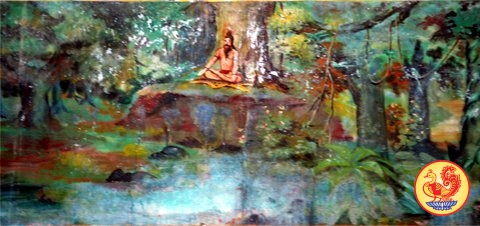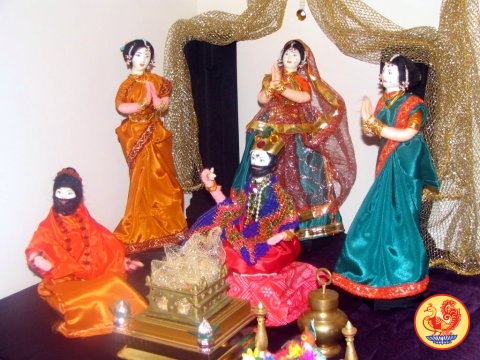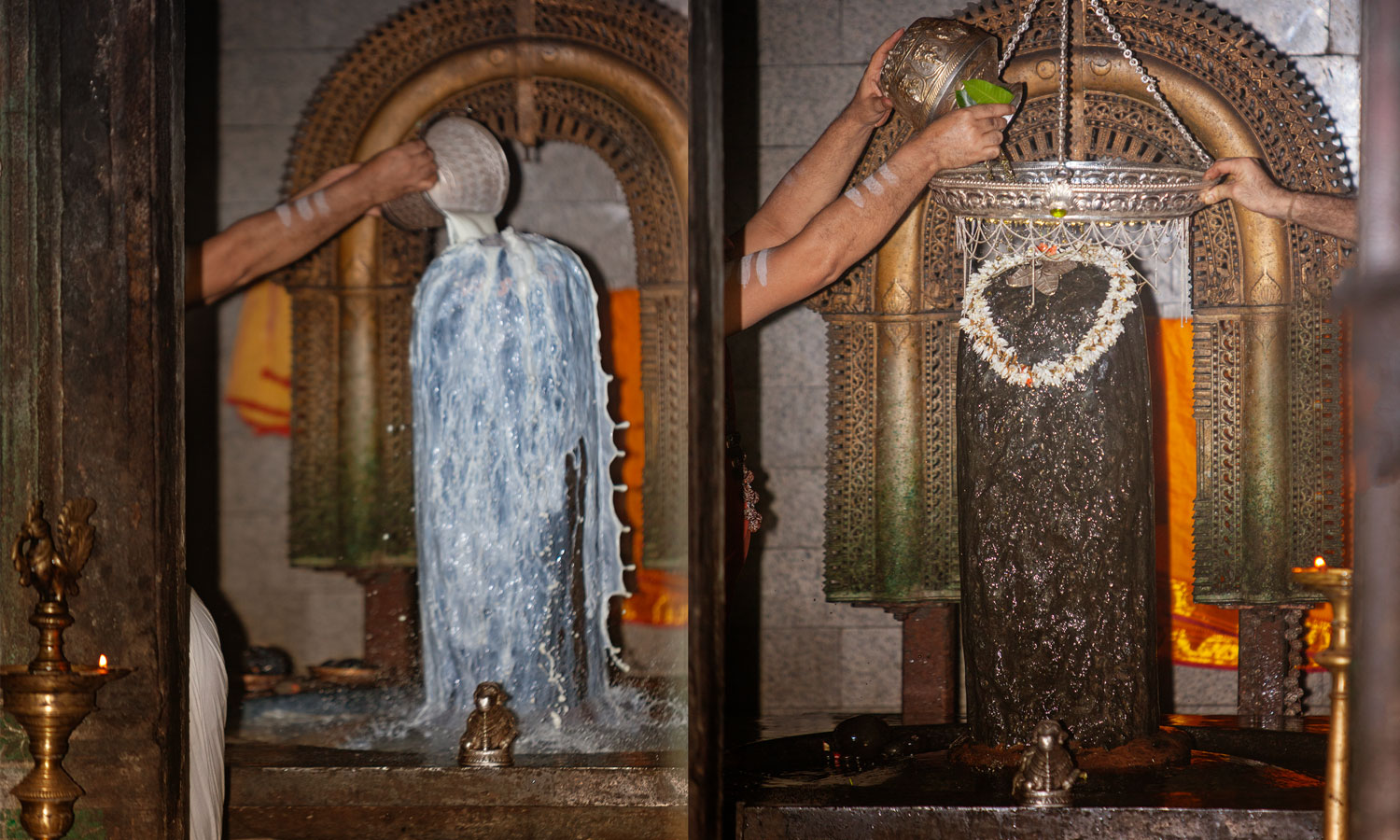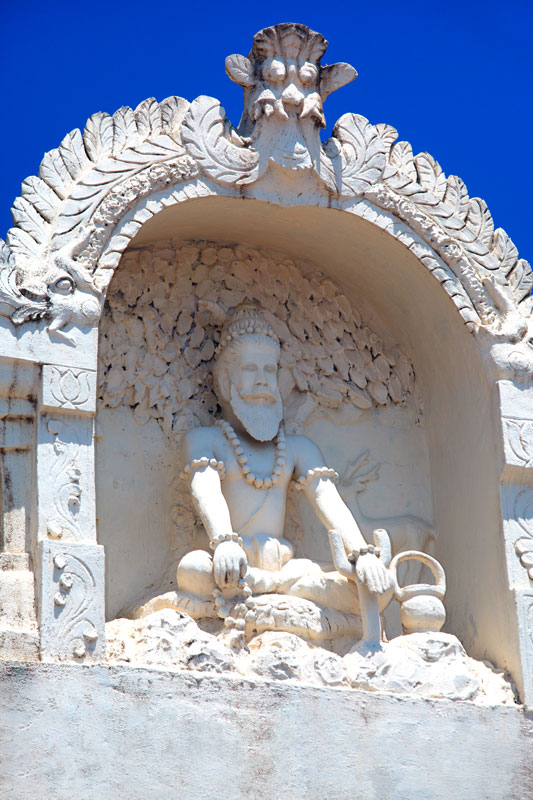
Jagadguru Shankaracharya Sri Sri Bharati Tirtha Mahaswamiji performing puja at the Sri Rishyashringa Temple at Kigga, near Sringeri
The Sacred Origins of Sringeri
Sringeri derives its sacred name from Maharshi Sri Rishyashringa, who chose this blessed place as His dwelling and performed intense penance here, consecrating it for eternity. The region where Maharshi Rishyashringa undertook his Tapas was originally called Rishyashringagiri, which has since evolved into the present name Sringeri.
Birth and Early Life
The extraordinary story of Maharshi Rishyashringa begins with his father, Maharshi Vibhandaka, who was the son of Maharshi Kashaypa. Through divine providence and unusual circumstances, Maharshi Vibhandaka became the father of a remarkable child born of a deer, distinguished by a horn upon his forehead. This child was named Rishyashringa, meaning "deer-horn."
Determined to shield his son from worldly distractions, Maharshi Vibhandaka raised him in complete forest isolation near the present day town of Sringeri. Rishyashringa was raised by his father, Maharshi Vibhandaka, in complete isolation by the banks of the river Tungabhadra. This area is nestled in the Western Ghats of India, in the present-day town of Sringeri. So successful was this protection that Rishyashringa grew to manhood having never encountered another human being besides his father, remaining innocent of worldly knowledge and even unaware of gender distinctions. Rishyashringa’s nature was pure and innocent, for his father ensured that his every thought and action was in accordance with the prescribed Vedic lifestyle of a Brahmachari.
On a small hill in this region, was a Shivalinga whose origins were deeply connected to his father, Maharshi Vibhandaka. Rishyashringa spent hours with his father worshiping this Shivalinga that bestowed upon him great spiritual powers. These holy powers, along with the purity of his nature and upbringing, made him the chosen instrument to usher in Sri Rama’s Avatara.

A Mural at Sringeri depicting the penance of Sage Vibhandaka
Ushering Sri Rama’s Avatara
During this time, the kingdom of Romapada suffered under a devastating drought. The king's wise counselors advised that only the blessed touch of Maharshi Rishyashringa's holy feet upon their soil could bring the life-giving rains their land desperately needed.
Acting upon this counsel, King Romapada dispatched court maidens to the forest. Carefully timing their approach during Maharshi Vibhandaka's absence, they successfully persuaded the young Maharshi to accompany them to the kingdom.
King Romapada himself waited at his kingdom's borders to receive the holy Maharshi. The moment Rishyashringa's feet touched the parched earth, the heavens responded immediately—clouds gathered and abundant rains began to fall, ending the drought and saving the kingdom.
Overwhelmed with gratitude, King Romapada offered his daughter Santha in marriage to the Maharshi. Rishyashringa accepted this union and remained as an honored guest in the royal palace.
It was during this period that King Dasharatha of Ayodhya sought the Maharshi's divine assistance. He invited Rishyashringa to officiate the sacred Putrakameshti Yaga, a ritual through which Dasharatha was blessed with four sons—including Sri Rama, the embodiment of righteousness and dharma. Reflecting on this momentous event, Maharshi Rishyashringa recognized the profound purpose of his married life: facilitating the advent of Sri Rama into the world.
It was at this time that Dasaratha, the King of Ayodhya, invited Sage Rishyashringa to officiate the yaga named Putrakameshti, by which he was blessed with four sons, Sri Rama and others. Sage Rishyasringa felt that His married life was not without its merits, since it gave Him an opportunity to usher Sri Rama, the personification of Dharma, into this world.

Doll arrangement depicting the performance of Putrakameshti Yaga by King Dasharatha officiated by Sage Rishyashringa
Return to Divine Contemplation
Despite the fulfillment found in his worldly duties, the maharshi felt an irresistible call to return to his native forest and its sacred atmosphere. He retired there to spend his remaining years in divine contemplation and worship.
When the time came for him to leave His mortal form, witnesses observed a brilliant streak of light emerge from His body and merge with the Shiva Linga he had been devotedly worshipping—the symbol of the formless Absolute.
Sacred Monuments
The Horned Linga at Kigga
This unique Shiva Linga, that was worshipped by Maharshi Rishyashringa, is located in the temple at Kigga village (7 km from Sringeri), bears a distinctive horn on its head, commemorating Maharshi Rishyashringa's divine merger. It can be visited and worshipped to this day.
Malahanikareshwara Temple
The Shiva Linga worshipped by Maharshi Vibhandaka, into which he too ultimately merged, stands atop a central hillock in Sringeri. Known as Malahanikareshwara—"destroyer of the soul's impurities"—this sacred shrine continues to receive devotees' worship and reverence.
These sacred sites and artistic treasures continue to inspire pilgrims and devotees, keeping alive the profound spiritual legacy of the maharshi who gave Sringeri its name and eternal sanctity.

Jagadguru Shankaracharya Sri Sri Bharati Tirtha Mahaswamiji performing puja to the Shiva-Linga of Sage Rishyashringa at Kigga

Sculpture at the temple of Sri Malahanikareswhwara at Sringeri depicting Sage Vibhandaka worshipping a Shiva Linga


